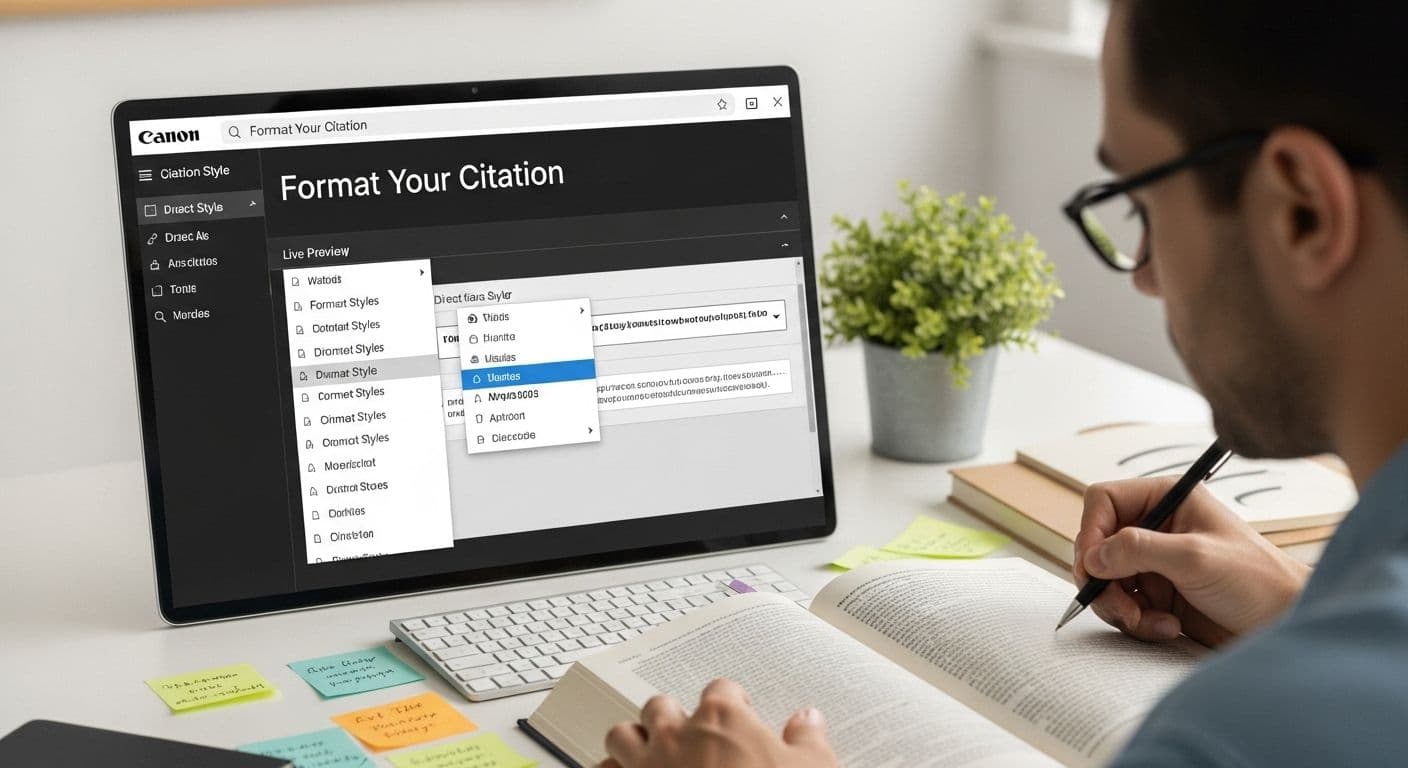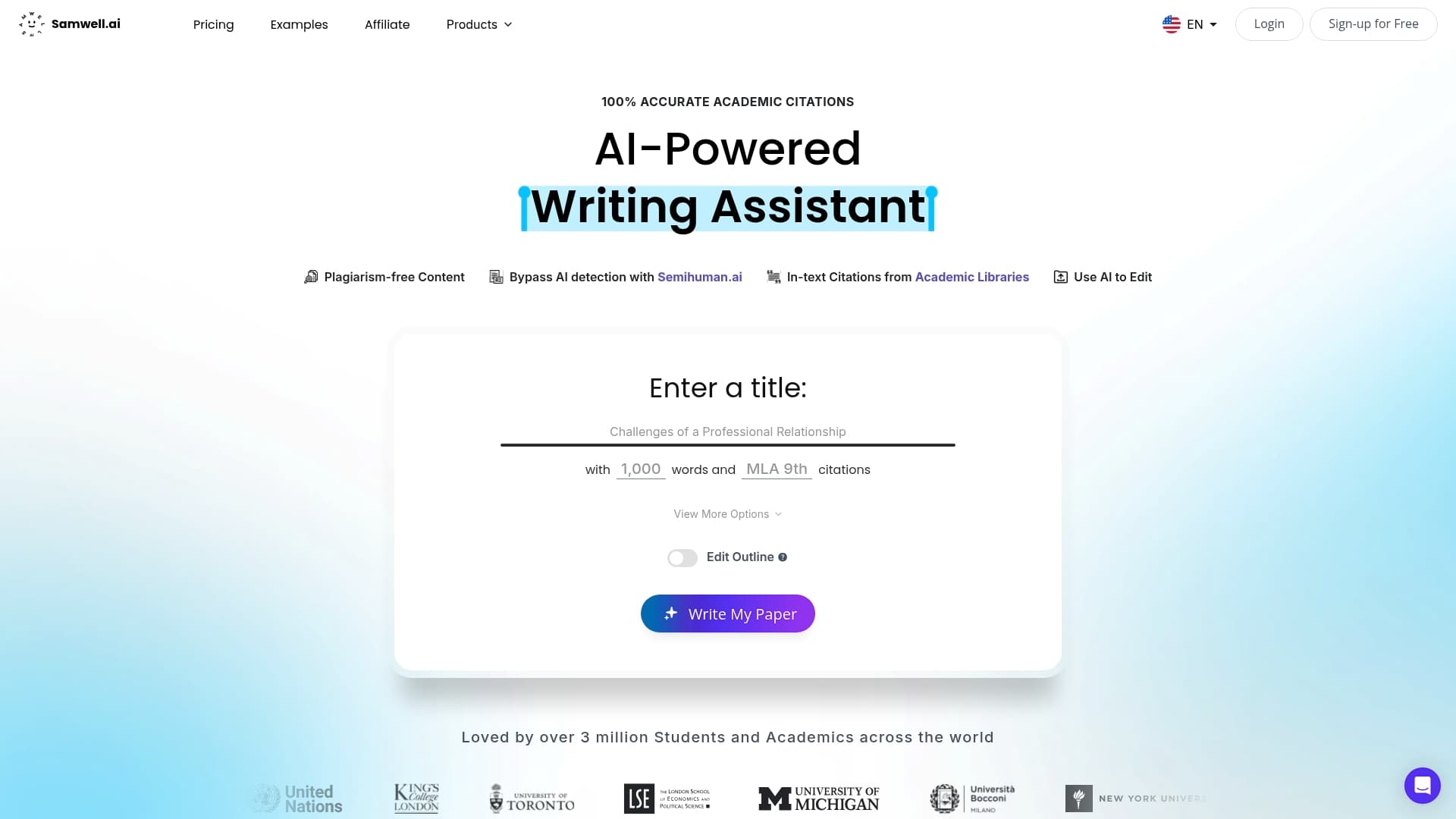Blog
Learning Materials
Master Direct Citation Example Skills for Research Success
Updated: September 4, 2025

Pinpointing credible sources is the first move in any strong research project. Some people are surprised to learn that academic databases like JSTOR and Google Scholar offer access to millions of peer-reviewed articles, giving you far more trustworthy material than a quick web search ever could. But building a solid reference list is only the beginning because mastering exactly what to cite and how to format it can change the course of your entire academic paper.
The following table summarizes the main steps for mastering direct citation skills in research, including each step's focus and the primary outcome achieved.
| Step | Focus | Key Outcome |
|---|---|---|
| 1 | Gather Relevant Source Materials | Establishes a strong foundation with credible, scholarly sources |
| 2 | Identify Key Information to Cite | Selects impactful and appropriate content for citation |
| 3 | Format Your Citation Correctly | Ensures citations meet academic style guidelines |
| 4 | Integrate Your Direct Citation Seamlessly | Creates a natural flow that supports the research argument |
| 5 | Verify Citation Accuracy and Compliance | Confirms the integrity and correctness of all citations |
Table of Contents
- Step 1: Gather Relevant Source Materials
- Step 2: Identify Key Information To Cite
- Step 3: Format Your Citation Correctly
- Step 4: Integrate Your Direct Citation Seamlessly
- Step 5: Verify Citation Accuracy And Compliance
Quick Summary
| Key Point | Explanation |
|---|---|
| 1. Define your research question clearly | A well-defined research question guides your source selection process for optimal results. |
| 2. Use academic databases for sources | Rely on platforms like Google Scholar and JSTOR to find credible, peer-reviewed materials. |
| 3. Identify critical information to cite | Focus on original research findings and unique insights that bolster your argument. |
| 4. Ensure accurate citation formatting | Follow specific style guidelines closely for each academic discipline to maintain professionalism. |
| 5. Verify all citations for accuracy | Cross-check citations against original sources to uphold academic integrity and prevent errors. |
Step 1: Gather Relevant Source Materials
Successful research begins with strategic source material collection. This foundational step determines the quality and credibility of your direct citation example process. Understanding how to identify, evaluate, and compile authoritative sources transforms an average research project into an exceptional academic work.
Researchers must approach source gathering as a systematic and intentional process. Start by defining your research question or thesis statement clearly, which will serve as a compass for source selection. Academic databases become your primary research allies in this initial phase. Platforms like Google Scholar, JSTOR, and university library catalogs offer peer-reviewed journals, academic publications, and scholarly articles that provide robust research foundations.
When searching for sources, utilize advanced search techniques that narrow results precisely. Employ Boolean operators like AND, OR, and NOT to refine your queries. Combine keywords strategically to capture the most relevant materials. For instance, if researching direct citation techniques, combine terms like "academic citation", "research methodology", and "scholarly writing" to generate comprehensive results.
Source evaluation requires a critical eye. Not all sources carry equal academic weight. Prioritize peer-reviewed journals, academic publications, and scholarly books over general web sources. Check each source's publication date, author credentials, and institutional affiliations. Recent publications within the last five years typically offer the most current research insights. Professional academic profiles and institutional affiliations can help verify an author's expertise.
Learn advanced research techniques for more comprehensive source gathering strategies. Developing a systematic approach ensures you collect high-quality, relevant materials that strengthen your research foundation and support precise direct citation examples.
Step 2: Identify Key Information to Cite
After gathering relevant sources, the critical next phase involves precisely identifying which information warrants direct citation. This step transforms raw research materials into a structured, academically rigorous narrative. Not every sentence requires citation, but understanding what constitutes citeable content is fundamental to research integrity.
Researchers must recognize three primary categories of information demanding citation: original research findings, unique interpretations, and specific data points. Statistical information, groundbreaking theories, specialized research methodologies, and expert analysis always require proper attribution. Conversely, common knowledge facts and widely accepted principles do not necessitate direct citations. The distinction requires careful judgment and academic discernment.
The identification process demands close reading and critical analysis. As you review your collected sources, highlight passages that represent significant contributions to your research question. Look for statements that provide unique insights, introduce novel perspectives, or present empirical evidence supporting your argument. Quantitative data like precise statistics, experimental results, and complex numerical analysis are prime candidates for direct citation. Similarly, qualitative research offering profound theoretical interpretations or groundbreaking conceptual frameworks deserve explicit acknowledgment.
Explore advanced citation techniques to refine your identification skills. When evaluating potential citations, consider their relevance, recency, and scholarly credibility. Academic sources published within the last five years typically carry more weight. Expert quotes from renowned scholars, research from prestigious institutions, and peer-reviewed journal articles provide the most reliable citation materials.
Verification becomes crucial in this step. Ask yourself key questions: Does this information significantly contribute to my research argument? Can I trace this information back to its original source? Would my readers benefit from understanding the precise origin of this information? These reflective checks ensure you select only the most meaningful and impactful citations for your research project.
![]()
Step 3: Format Your Citation Correctly
Formatting citations requires precision and attention to specific academic style guidelines. Different academic disciplines demand unique citation formats, making it crucial to understand the nuanced requirements of your specific research field. Whether you are working with APA, MLA, Chicago, or Harvard style, each format has distinctive rules governing how sources are referenced within your document.
Begin by identifying the required citation style for your research project. Academic departments and journal submission guidelines typically specify the exact citation format. Pay careful attention to minute details such as punctuation, italicization, author name placement, and year of publication. Consistency becomes paramount when formatting citations, as even small variations can undermine the professional appearance of your research.
Digital tools can significantly streamline the citation formatting process. Reference management software like Zotero, Mendeley, and EndNote automatically generate correctly formatted citations across multiple style guidelines. These platforms allow researchers to input source information once and generate citations in various formats with minimal manual intervention. When using these tools, double-check the generated citations against your specific style guide to ensure absolute accuracy.
Discover comprehensive citation formatting strategies that will elevate your research presentation. In-text citations require specific formatting based on the number of authors, source type, and direct versus paraphrased content. For instance, a single-author source might be cited differently compared to a multi-author publication. Understanding these nuanced variations prevents potential citation errors that could impact your research's academic credibility.

Verification remains a critical final step in the citation formatting process. Review each citation meticulously, confirming that author names are spelled correctly, publication years match source documents, and formatting adheres precisely to required style guidelines. A systematic approach ensures your citations not only provide proper academic attribution but also demonstrate your commitment to scholarly rigor and professional research standards.
Step 4: Integrate Your Direct Citation Seamlessly
Successful academic writing hinges on the ability to integrate direct citations that flow naturally within your text. Citations are not mere decorative elements, but critical components that strengthen your research argument by providing authoritative support for your claims. The art of seamless integration transforms isolated quotes into powerful narrative threads that enhance your scholarly narrative.
Begin by introducing each citation contextually. Effective integration requires more than simply dropping a quote into your text. Craft an introductory phrase that provides context, explaining why the citation matters and how it connects to your broader argument. This approach signals to readers that the cited material is not random but purposefully selected to illuminate a specific point. Verb choice becomes crucial in this introduction. Words like "argues," "demonstrates," "reveals," or "highlights" help frame the citation's intellectual contribution.
Pay close attention to grammatical consistency when incorporating direct quotes. The cited text should grammatically align with your surrounding sentences, creating a smooth reading experience. If necessary, use square brackets to modify the quote slightly, ensuring it fits seamlessly into your narrative structure. Parenthetical citations should be placed strategically, typically at the end of the sentence or immediately after the quoted material, maintaining the natural flow of your academic prose.
Explore advanced citation integration techniques that can elevate your research writing. Consider the length and purpose of your citations. Short, precise quotes often pack more analytical punch than lengthy block quotations. When possible, paraphrase complex passages, using direct quotes only for particularly impactful or nuanced statements that cannot be effectively restated.
Verification involves a critical read-through of your integrated citations. Ask yourself: Does each citation genuinely support my argument? Is the source clearly introduced? Can a reader understand the quote's relevance without additional explanation? Your goal is to create a seamless scholarly conversation where external sources feel like natural participants in your research dialogue, not disruptive interruptions.
Step 5: Verify Citation Accuracy and Compliance
The final stage of direct citation mastery involves meticulous verification and compliance checking. Academic integrity hinges on precise citation accuracy, making this step crucial for maintaining scholarly credibility. Researchers must approach this verification process with systematic thoroughness, examining every citation for potential errors or inconsistencies.
Begin by cross-referencing each citation against its original source document. Verify that quotation marks are exact, page numbers are correct, and author names are spelled precisely as they appear in the original publication. Pay special attention to small details like punctuation, capitalization, and formatting variations that could potentially invalidate your citation. Digital tools like reference management software can assist in this verification process, but manual review remains essential for catching nuanced errors that automated systems might miss.
Comprehensive compliance involves more than just matching text. Evaluate whether each citation adheres to the specific style guide requirements of your academic discipline. Different fields like psychology, history, or engineering have unique citation protocols. Confirm that in-text citations match the reference list, checking that every cited source appears in your bibliography and vice versa. Examine the formatting of your reference entries, ensuring they follow the exact guidelines for author names, publication dates, titles, and other bibliographic information.
Discover advanced citation verification techniques that can help prevent potential academic misconduct. Digital plagiarism detection tools can provide an additional layer of verification, helping researchers ensure that citations are not only accurate but also properly distinguished from original writing. Create a systematic checklist that includes key verification points:
- Exact quote matching with original source
- Correct page number references
- Proper author name spelling
- Consistent formatting across citations
- Matching in-text and bibliography entries
Final verification requires a patient, methodical approach. Read through your entire document, treating each citation as a critical piece of evidence. Successful verification means your research stands as a credible, well-documented scholarly contribution, demonstrating your commitment to academic excellence and intellectual rigor.
Use this checklist table to verify citation accuracy and compliance before submitting your academic paper. Each item corresponds to a critical aspect of citation validation discussed in the article.
| Verification Step | Description |
|---|---|
| Exact Quote Matching | Confirm quoted material matches the source word-for-word |
| Correct Page Reference | Ensure page numbers are accurate for all direct quotes |
| Author Name Spelling | Double-check spelling as it appears in the source |
| Formatting Consistency | Review formatting against required citation style |
| Reference List Matching | Ensure every in-text citation is listed in bibliography |
| Punctuation and Capitalization | Verify correct use in all citation entries |
| Compliance with Style Guide | Confirm adherence to academic discipline rules |
Take Your Direct Citation Skills from Theory to Practice with Samwell.ai
Struggling to gather credible sources, master citation formats, or ensure that every quote in your research is seamlessly integrated and fully compliant? If the step-by-step approaches outlined in "Master Direct Citation Example Skills for Research Success" sound overwhelming, you're not alone. Many students and academics face uncertainty when separating citeable information from common knowledge, formatting references for different style guides, or double-checking each detail for accuracy. This process can be stressful and time-consuming, especially when your academic reputation is on the line.

Experience research writing support built for real academic pressures. Samwell.ai is designed to solve exactly these challenges. Tap into advanced AI that not only helps you find top-tier sources but also generates and formats citations in APA, MLA, or any style you need. Take advantage of the Power Editor to review and enhance your drafts, quickly verify your citations for accuracy, and conduct AI checks to ensure originality. Discover more about efficient, academically rigorous writing at Samwell.ai and get the edge you need for your next project. Start today—turn anxiety over citations into clarity and confidence.
Frequently Asked Questions
What are the key steps for gathering relevant source materials in research?
Successful research begins with defining your research question or thesis statement. Use academic databases like Google Scholar, JSTOR, and university library catalogs to find peer-reviewed journals and scholarly articles. Employ advanced search techniques with Boolean operators to refine your queries and identify authoritative sources.
How do I determine what information requires direct citation in my research?
Citable information typically falls into three categories: original research findings, unique interpretations, and specific data points. Elements like statistical information, groundbreaking theories, and expert analysis need proper attribution, while common knowledge does not.
What are the common citation formats used in academic writing?
Common citation formats include APA, MLA, Chicago, and Harvard styles. Each academic discipline may specify a particular format, so it’s crucial to understand the requirements and nuances of the designated style for your research project.
How can I ensure my citations are integrated seamlessly into my writing?
To integrate citations effectively, introduce each one with contextual information and a clear connection to your argument. Ensure grammatical consistency and place citations strategically within your sentences to maintain the overall flow of your academic prose.
Generate essays with Samwell.ai
Whether you’re a publisher, professor, journalist, or student, let us tailor a plan just for you.Most Read Articles

Your Guide to Help Writing a Essay Successfully
Expert tips for help writing a essay - from crafting a thesis to structuring your essay effectively.

How to Write Critical Thinking Essay: Expert Tips
Expert tips for writing a critical thinking essay. Learn how to structure, choose topics, and use evidence effectively.'

How to Write a Good Hook: A Step-by-Step Guide
Master the art of crafting a good hook with our guide. Create compelling openers for a memorable first impression.
